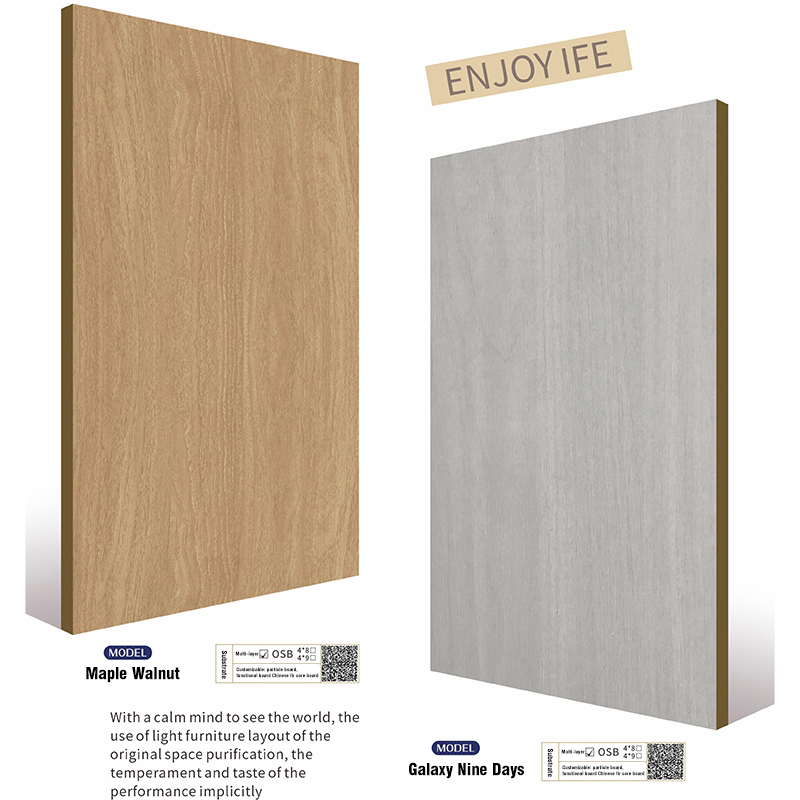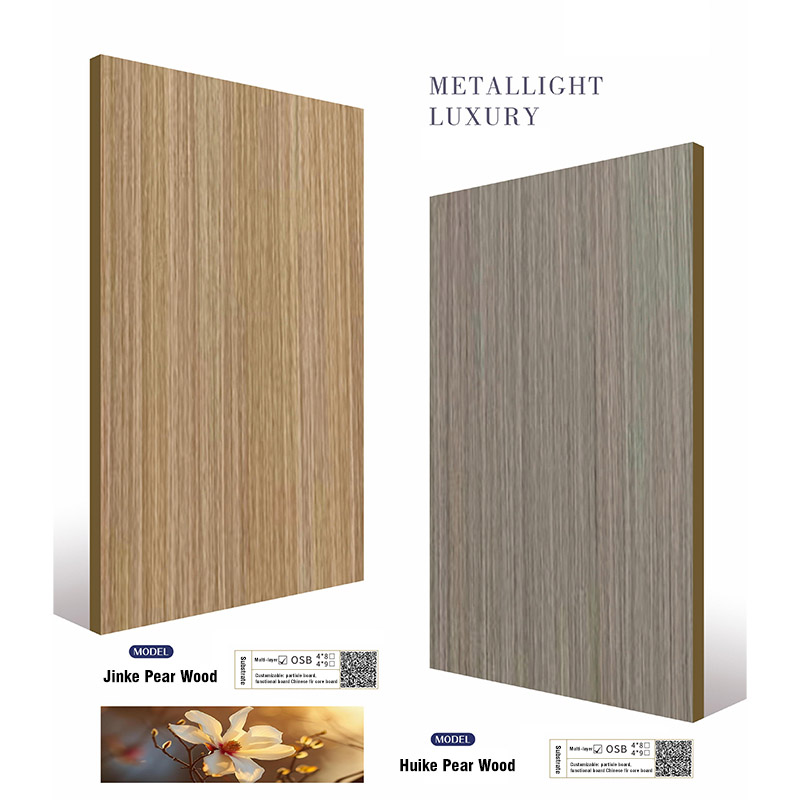Is the internal structure of jinke pear wood/huike pear wood board base material uniform and dense?
Release Time : 2025-10-22
In the manufacturing of high-end furniture and custom spaces, the inherent quality of the board base material often determines the lifespan and performance of the finished product. No matter how exquisite the surface finish, a loose base material with uneven density will struggle to withstand the challenges of delicate processing and long-term use. One of the core advantages of jinke pear wood/huike pear wood board base material, which has earned its trust within the industry, lies in its highly uniform and dense internal structure. This characteristic not only ensures the overall strength of the board but also demonstrates exceptional stability and reliability during actual processing.
The dense structure of high-quality base material stems from rigorous raw material selection and precise control of advanced production processes. The wood fibers are thoroughly decomposed and reorganized, achieving a high degree of cross-linking during the hot pressing process, forming a densely packed layered or network structure. This uniform internal structure avoids the localized voids, bubbles, or uneven fiber agglomerations common in traditional boards, ensuring consistent physical properties from the core to the surface. Whether subjected to horizontal or vertical forces, the material evenly transmits stress, preventing crack propagation due to overly fragile points.
Drilling is one of the most common machining processes in furniture manufacturing, used to install hardware such as hinges, connectors, and shelf supports. If density variations exist within the base material of jinke pear wood/huike pear wood board, the sudden change in resistance during drill entry can cause tearing at the edges or roughening of the hole walls. In severe cases, it can even cause the entire board to crack. The uniformly dense structure of jinke pear wood and huike pear wood base materials effectively resists the shear forces of drilling, resulting in smooth, complete hole edges with no noticeable chipping or delamination. This not only improves processing efficiency and reduces rework, but also provides a solid foundation for subsequent hardware installation.
Edges and corners are particularly vulnerable to damage, especially during handling, cutting, and edge banding. Loose edges in the base material of jinke pear wood/huike pear wood board are prone to chipping and chipping, affecting the overall aesthetic and sealing performance. The dense internal structure also ensures high impact resistance on the edges, ensuring they remain intact even from minor bumps, ensuring a secure bond between the edge banding and forming a complete moisture-proof barrier. This integrity is particularly important for products exposed to moisture for extended periods, such as kitchen cabinets and bathroom furniture.
More importantly, the strength of hardware nail grip directly impacts the stability and safety of furniture. The durability of hinges and the ability of shelving to withstand load without deformation all depend on the board's ability to hold screws. Loose substrates can easily cause screws to spin or slip after being screwed in, leading to loosening, sagging, or even falling off over time. Jinke and Huike pear wood panels, with their dense fiber network, provide strong support for hardware. Screws provide uniform resistance during insertion, creating a tight engagement between the threads and the board, ensuring a secure lock even after repeated assembly and disassembly, ensuring smooth door opening and closing and a stable cabinet structure.
Furthermore, this uniform and dense structure enhances the board's adaptability to temperature and humidity fluctuations. Under environmental fluctuations, the material's expansion and contraction tend to be consistent, making it less susceptible to warping or deformation due to internal stress imbalances, further ensuring the furniture's long-term flatness and aesthetics.
Ultimately, the inherent quality of the Jinke pear wood/Huike pear wood board base material, though invisible, permeates the entire lifecycle of each piece of furniture. From the first cut to final delivery, through daily use and for years to come, the Jinke and Huike pear wood boards, with their stable internal structure, silently support the realization of the design and the continuation of its functionality. More than just a material, they are the silent embodiment of craftsmanship and manufacturing standards, conveying a relentless pursuit of quality in every inconspicuous hole, every corner, and every opening and closing.
The dense structure of high-quality base material stems from rigorous raw material selection and precise control of advanced production processes. The wood fibers are thoroughly decomposed and reorganized, achieving a high degree of cross-linking during the hot pressing process, forming a densely packed layered or network structure. This uniform internal structure avoids the localized voids, bubbles, or uneven fiber agglomerations common in traditional boards, ensuring consistent physical properties from the core to the surface. Whether subjected to horizontal or vertical forces, the material evenly transmits stress, preventing crack propagation due to overly fragile points.
Drilling is one of the most common machining processes in furniture manufacturing, used to install hardware such as hinges, connectors, and shelf supports. If density variations exist within the base material of jinke pear wood/huike pear wood board, the sudden change in resistance during drill entry can cause tearing at the edges or roughening of the hole walls. In severe cases, it can even cause the entire board to crack. The uniformly dense structure of jinke pear wood and huike pear wood base materials effectively resists the shear forces of drilling, resulting in smooth, complete hole edges with no noticeable chipping or delamination. This not only improves processing efficiency and reduces rework, but also provides a solid foundation for subsequent hardware installation.
Edges and corners are particularly vulnerable to damage, especially during handling, cutting, and edge banding. Loose edges in the base material of jinke pear wood/huike pear wood board are prone to chipping and chipping, affecting the overall aesthetic and sealing performance. The dense internal structure also ensures high impact resistance on the edges, ensuring they remain intact even from minor bumps, ensuring a secure bond between the edge banding and forming a complete moisture-proof barrier. This integrity is particularly important for products exposed to moisture for extended periods, such as kitchen cabinets and bathroom furniture.
More importantly, the strength of hardware nail grip directly impacts the stability and safety of furniture. The durability of hinges and the ability of shelving to withstand load without deformation all depend on the board's ability to hold screws. Loose substrates can easily cause screws to spin or slip after being screwed in, leading to loosening, sagging, or even falling off over time. Jinke and Huike pear wood panels, with their dense fiber network, provide strong support for hardware. Screws provide uniform resistance during insertion, creating a tight engagement between the threads and the board, ensuring a secure lock even after repeated assembly and disassembly, ensuring smooth door opening and closing and a stable cabinet structure.
Furthermore, this uniform and dense structure enhances the board's adaptability to temperature and humidity fluctuations. Under environmental fluctuations, the material's expansion and contraction tend to be consistent, making it less susceptible to warping or deformation due to internal stress imbalances, further ensuring the furniture's long-term flatness and aesthetics.
Ultimately, the inherent quality of the Jinke pear wood/Huike pear wood board base material, though invisible, permeates the entire lifecycle of each piece of furniture. From the first cut to final delivery, through daily use and for years to come, the Jinke and Huike pear wood boards, with their stable internal structure, silently support the realization of the design and the continuation of its functionality. More than just a material, they are the silent embodiment of craftsmanship and manufacturing standards, conveying a relentless pursuit of quality in every inconspicuous hole, every corner, and every opening and closing.







